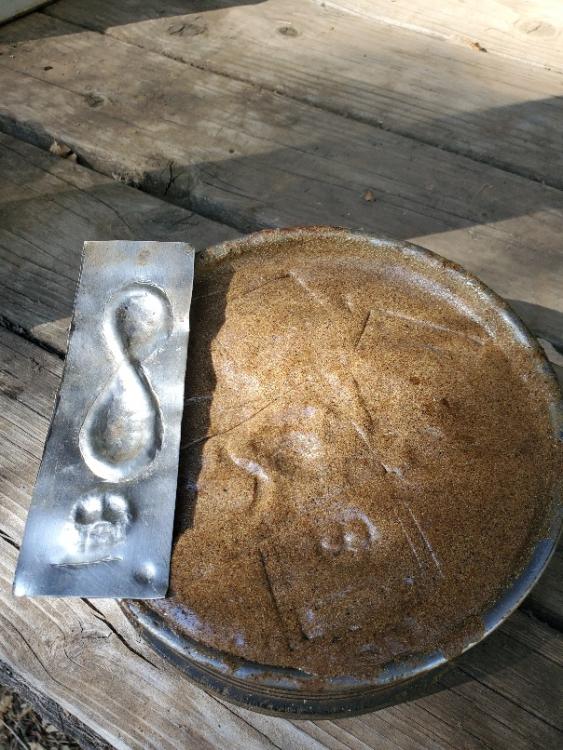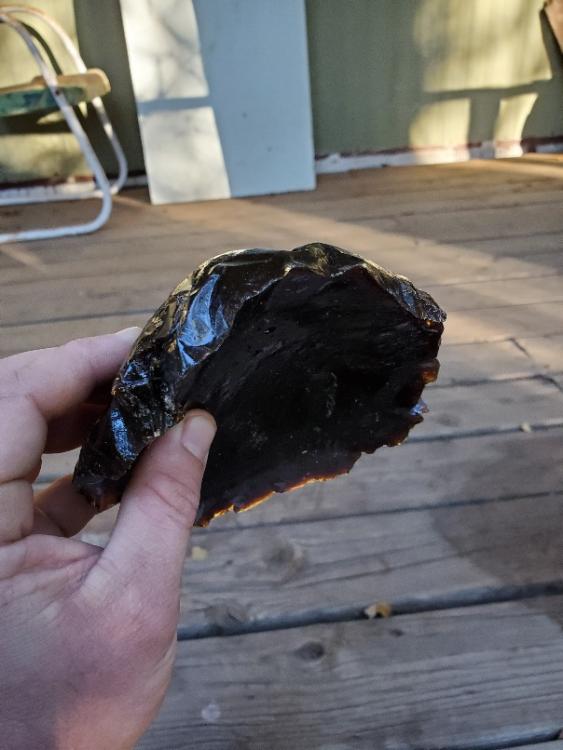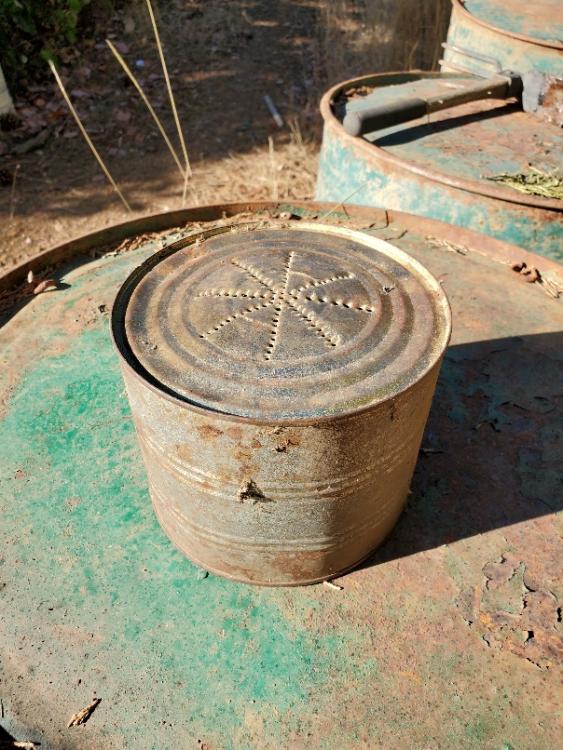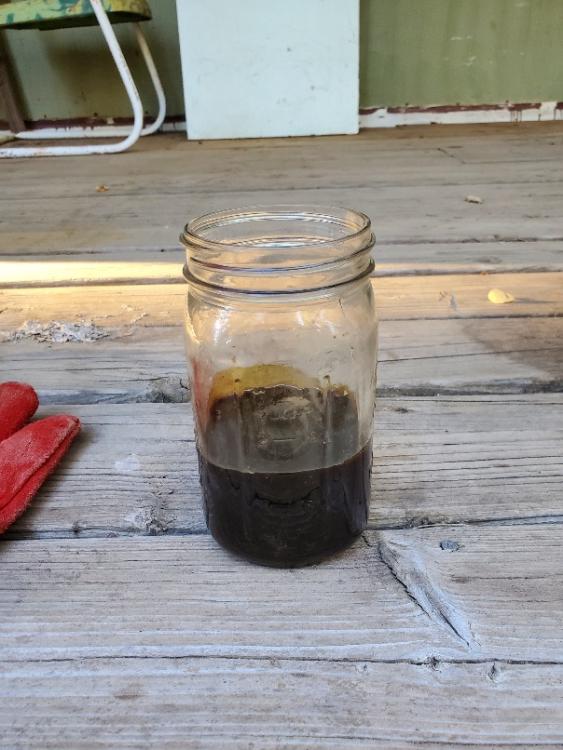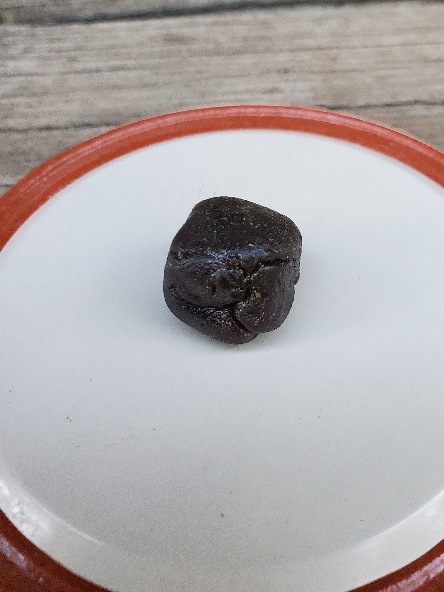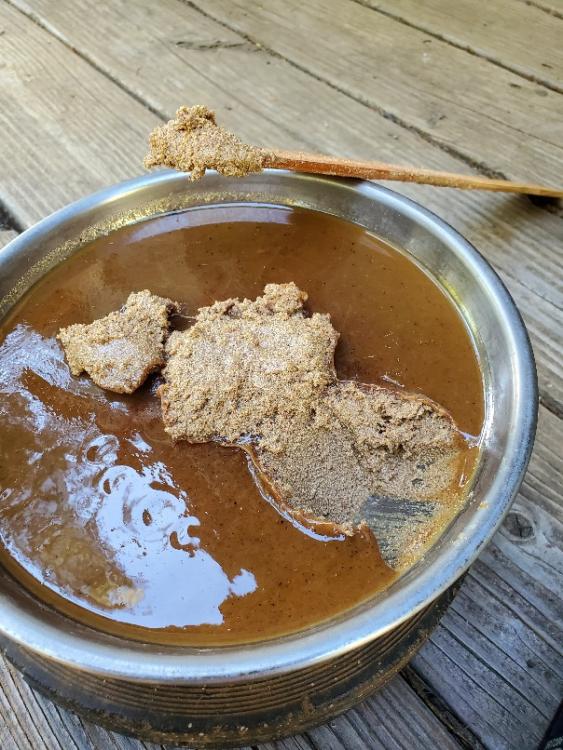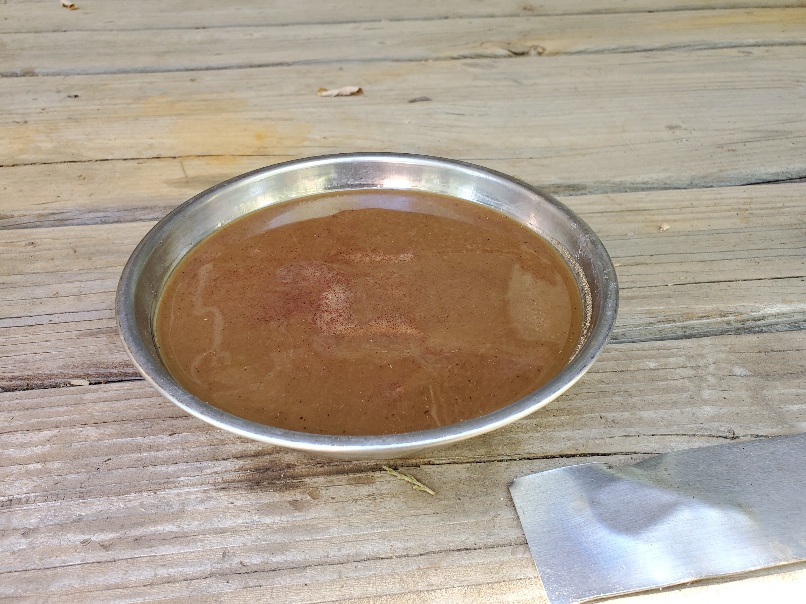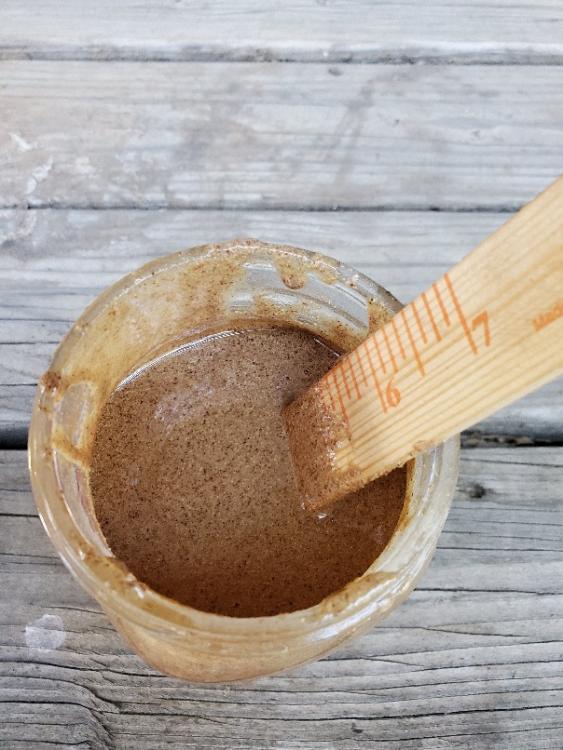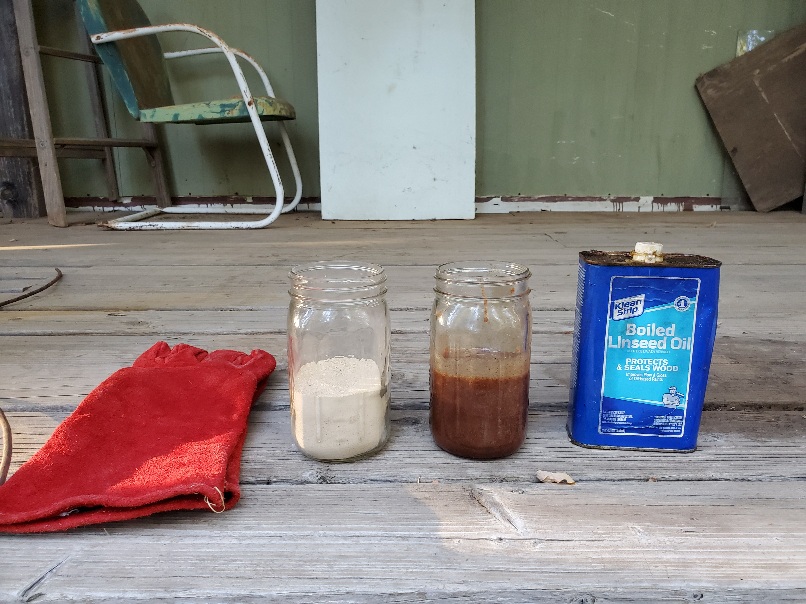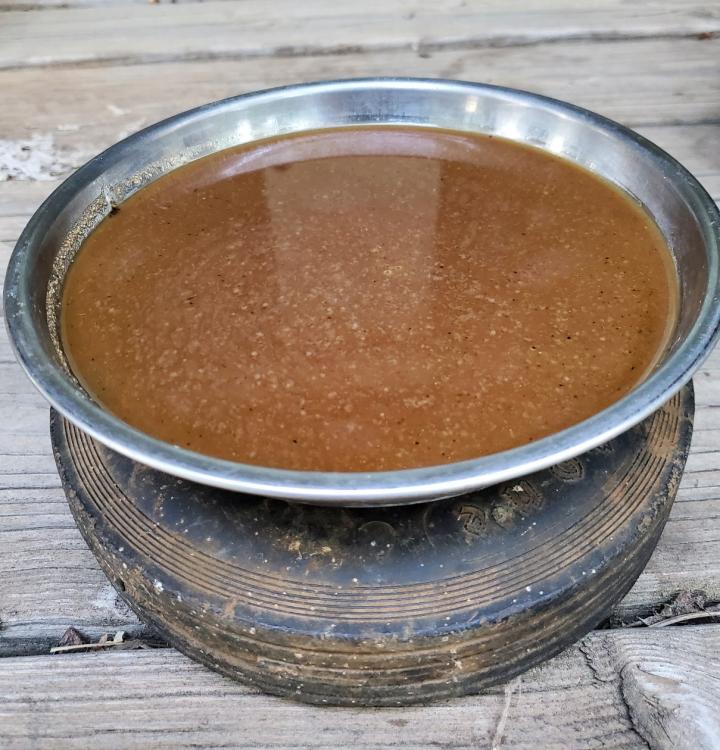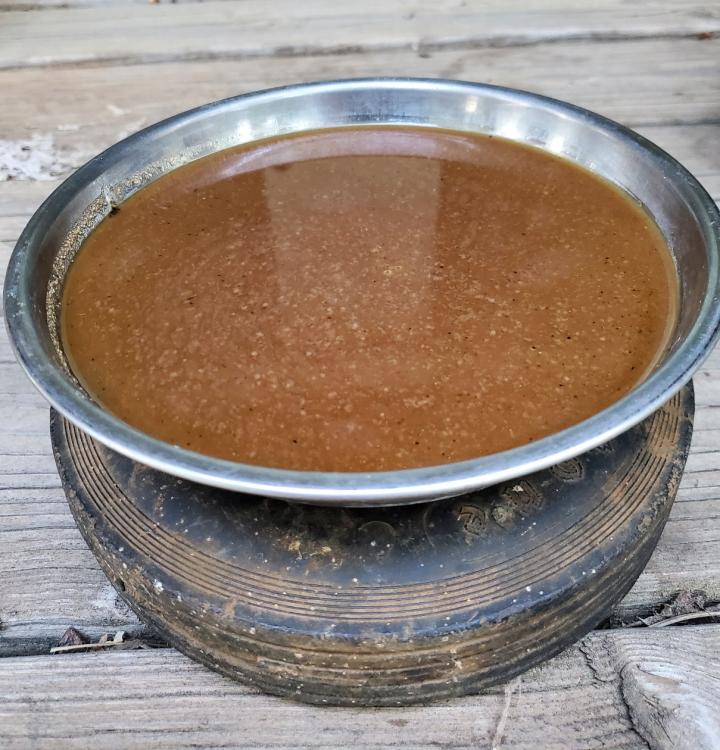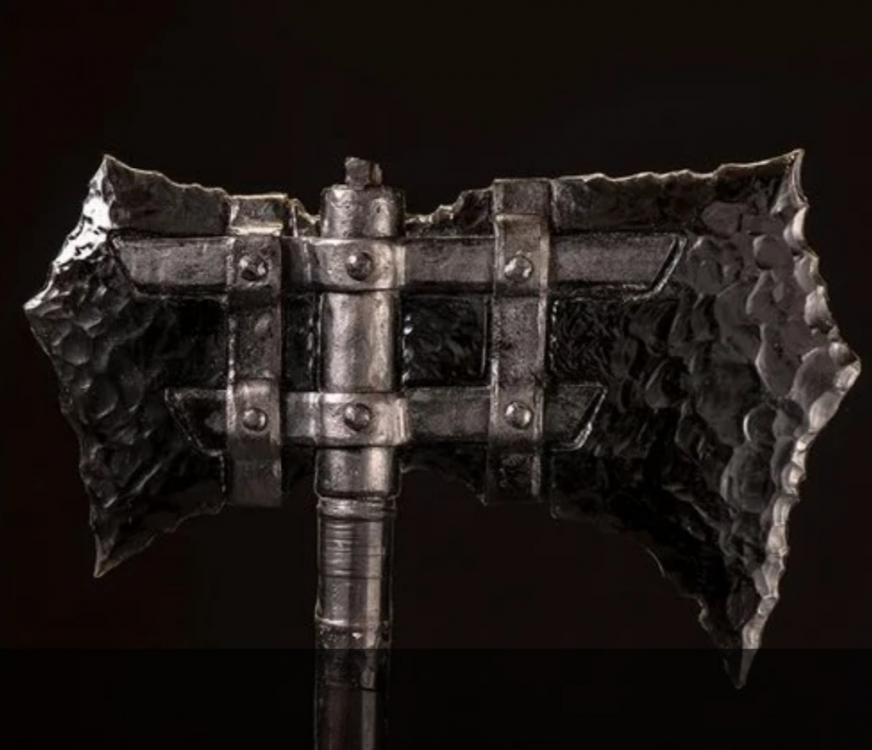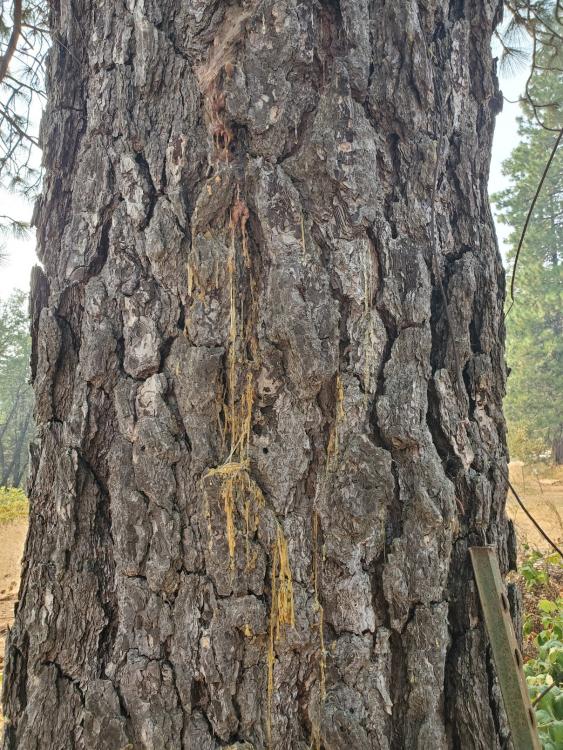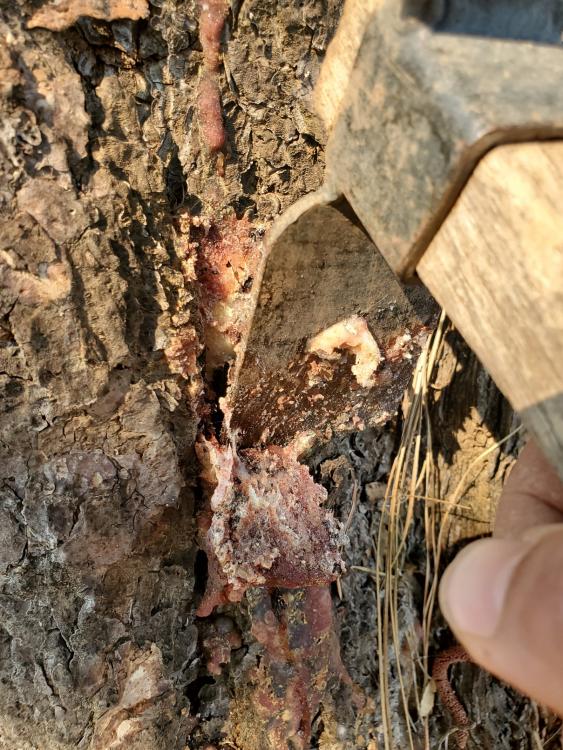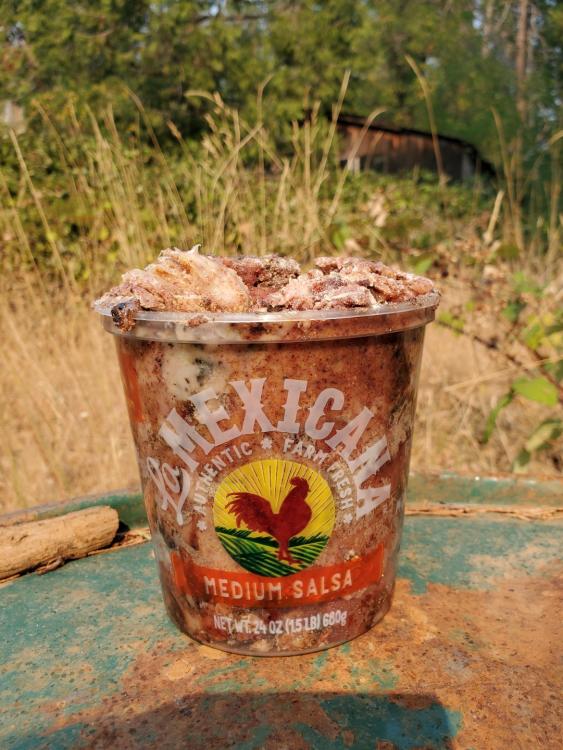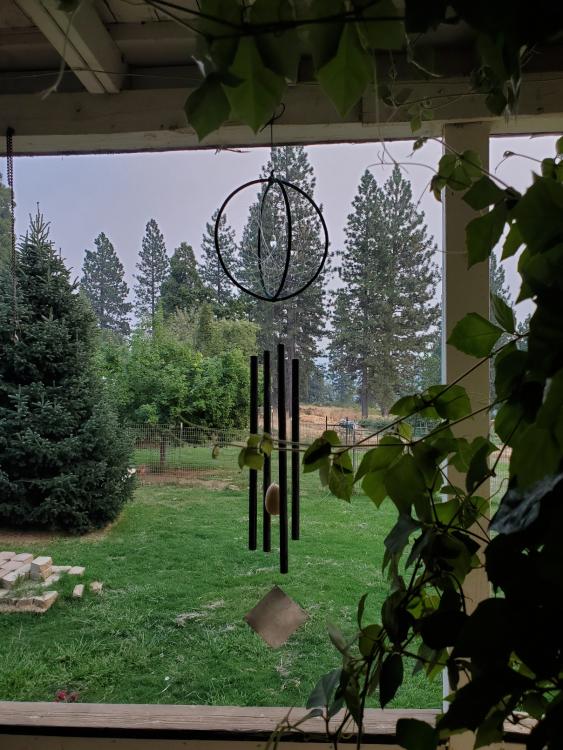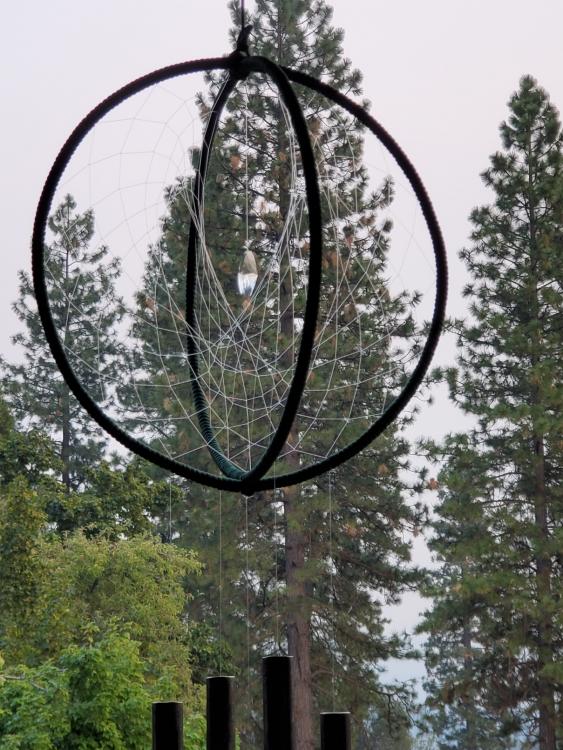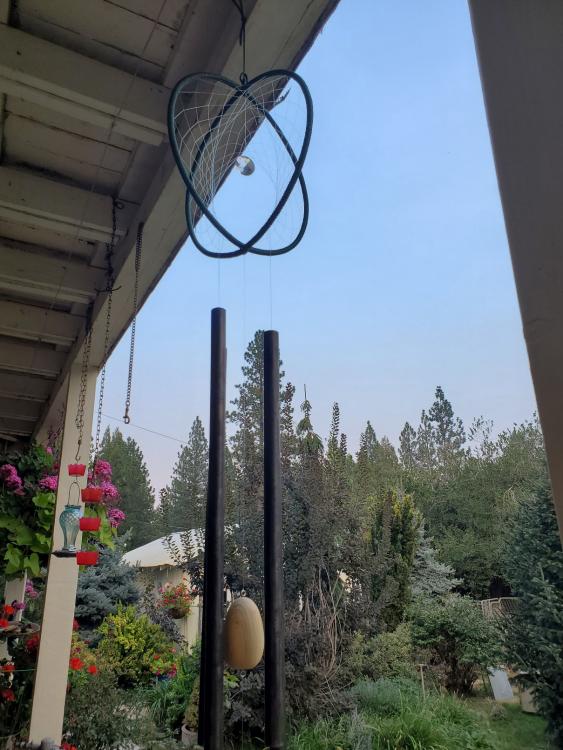-
Posts
399 -
Joined
-
Last visited
Content Type
Profiles
Forums
Articles
Gallery
Downloads
Events
Everything posted by Shabumi
-
I keep trying to swab with hot pitch but everytime I turn, my tail keeps running away. One of these days...
-
I have so far, though the round about way of getting where I am isn't the most accurate. I've been chasing my tail with this pitch longer than I expected. From my smaller experiments the ratio I liked ended up at 10 pt rosin, 5 pt brick dust and 1 pt BLO. Haha, sounds like me. I couldn't hit the broad side of a barn if I stood 2 feet away.
-
So, I've been playing around with the rosin I made. I took 1/4 of it and made the same recipe I used before, only with rosin instead of resin, and it made a huge difference. Still too soft, but much better. I took half of the mixture and added more rosin and in the other half I added more brick dust. The one with more brick dust stayed the same, I just had more of it, while the one with more rosin got harder. With this information I went back to my first attempt and added the test samples and the rest of the rosin I had made, about a cup and a half more. It turned out really well. Between 60f and 70f It sticks well but all I have to do is give a quick jerk away from the bowl and the piece comes right off without much, if any, residue. Above 70f it takes a lick from a torch to release. Above 80f and it has the consistency of a warm Abba-zabba, so I'll need to keep it cool. I could add more rosin to make it harder, but I'm out for now so it'll do. Here's the piece I played around with to test the pitch out. This was at around 65f.
-
-
Paracletes, didn't he say "The interpretation of dreams is great art."? The pitch was much tighter this morning. Still soft, but homogenous and kept its shape at room temp, so thats progress. Im going to set this batch aside for now. Instead I gathered some more pitch, and found a easier and reusable way to strain the sap. A large can with holes punched in the bottom, set upon a heat lamp shade, which funnels into a mason jar. Slowly torch the outside of the can and let it drip. I went for the more solid sap, but got some soft stuff as well. Turns out that I got it hot enough to draw off alot of the volatiles with this method as it came out around 300f and wasn't bubbling. I cooled a bit and it was hard at room temp. I did this all outside with an extinguisher and a lid to smother in case of flare-ups, of which there were 2.
-
Ok, last night before bed I added another half cup of brick dust, because thats what I had left from before. It made it better, but there was still a goo slick on top after it sat overnight, and was soft enough to stir at room temp. I took it this evening and boiled it in the microwave. 30 second on 1 minute off until it stopped bubbling at 250f on my IR thermometer, about 45 minutes. Even with the extra brick dust it reduced down to 3 cups. I'll see if it helped after it cools overnight.
-
Yes, that's the stuff. When I looked into it, rosin has a long and varied history as a tool. From one of the earliest tools used by man, as a glue, to making torches, being used to increase traction at sporting events, to being a lapping base for polishing telescope mirrors. It should also be available at any apothecary at your local ren fair. If they dont have it, then I'd be wary of frequenting such a disreputable establishment. Ah, there is the difference i wasn't seeing. Thank you for clarifying that for me. Too pliable is a good term to describe it, but it's more flowy than sticky, it wipes away easily from the piece and your hands. It's more like the brick dust settled and left the goo on top. The piece felt supported underneath and didn't sink much. I will definitely try adding more dust to it, thank you for the suggestion. Im just a little worried that its still going to be rocks in a puddle of goo instead of a homogeneous glob. If more dust doesn't work, ill set up some sort of double boiler for it. While I'm at it I may gather some more resin to boil down to rosin for a second try. The way I am understanding it now, and please correct me if I'm wrong, is that the brick dust adds body and heat retention, the rosin adds hardness and stickyness and the oil/wax tempers the other ingredients by making it more pliable and less sticky
-
None specified, though they use wax in its place in some recipes and that is hardened at room temp. It might have helped having the hardening in my recipe. With further reading and based on his (Russell Baron) description of what he was using I realized that while he says pine resin he meant pine Rosin, which is solid at room temperature. Resin turns to Rosin as it ages, but you can speed it up by boiling out the natural turpentine. I used resin that was still tacky at room temp and my pitch ended up way too soft. I tried a quick sample of aluminum. It had good support under the piece, but it flowed over the top and I only got a few hits in before my piece was nearly buried in the pitch. By the time I melted the residue back into the bowl, the pitch in the bowl had settled back to flat. I'm not sure how well it will evaporate now that its been mixed with an oil, but I may be able to salvage this batch and boil out some of the turpentine to try and harden it. Though I may have to start over and boil the pine pitch longer to get Rosin to start with.
-
This is a look at my journey into making my own repousse/chasers pitch. It started by me wanting to decorate the aluminum sail of the wind chime I made. Looking around on Iforgeiron and a couple quick searches I see that pine pitch is a main ingredient. I have pines aplenty so I go gathering and choose a old vague recipe from Theophilus' On Divers Arts to start the journey. "Grind a piece of brick or tile very small and melt some pitch in an earthenware dish and add a little wax. When these are both melted, mix in the powdered tile and stir it vigorously and pour it out into water. When it begins to grow cold, dip both your hands into the water and knead it for a long time until you can stretch the composition and draw it out like a skin. Immediately melt this composition and fill the cruet to the top." During the time I was straining the pine pitch and crushing the brick I decided to do some more research. There was a little info here on IFI, but not much. Only one recipe.,(I don't know how to link other posts, so I'll just quote it.) "Posted January 1, 2006 by meco3hp 8 oz of brick dust 1 oz of resin 1 tbl of linseedoil Heated and mixed together." I found a few more recipes when I did an online search for repousse or chasers pitch recipe. Sorry, I only got a few of the names of who posted them on other forums, and I forgot to get the site names. I wasn't planning on all this when I gathered them. "Pine Rosin Pitch mixture: Matsu-yani 1 Kg finely ground fire clay or Plaster of Paris 750 grams of Pine Rosin 50 ml of vegetable oil 1 teaspoon of charcoal powder." "from Oppi Untracht: 'Metal Techniques for Craftsmen', (p95): 6 parts pitch 4 parts plaster of paris 1 part vegetable oil" "• 16 parts pitch • 20 parts plaster of Paris • 4 parts resin • 1 part tallow The pitch is heated until molten. Plaster of Paris is added a small amount at a time. Resin and tallow are then mixed in" Then I found a thesis written by a RIT student named Russell Baron. His thesis is open source, so I'm including it here.Pitch problems and processes.pdf It shows his experiments of trying to create a chasers pitch with similar properties to whats commercially available. He tries out different emollients (oils and waxes) as well as different proportions of pine pitch-filler-emollient. Very informative. He also has 11 recipes from jewlers literature with sources, which he uses as a starting point for his recipes. I ended up using a slight variation on his recipe, D-2. It looked like it had the best properties based on my available ingredients. The recipe I used is: 10 parts pitch= 2 cups pine resin ~7 parts filler= a light 1.5 cups of brick dust (should be 1.4 cups, but I figured the ballpark was good for this one) ~1.5 part emollient = 1/3 cup BLO Melt the resin. Mix in BLO. Slowly mix in brick dust. I ended up with about 3.5 cups of finished product I lost my kitchen privileges when I strained the pitch, so I had to use an old microwave that barely works to heat the pitch instead of a double boiler. If you must do it this in a microwave, do it 30 seconds on/1 minute off. You do NOT want this to boil over into your microwave. I was careful and it only took 15 minutes to get it to mixing temperature, which is way too hot for bare skin so be sure to use PPE, leather gloves and safety glasses. After it was all mixed I put it in my pitch bowl, a small stainless bowl that fits in a small rubber tire. I will test it out when I have a bit of time, hopefully in the next few days.
-
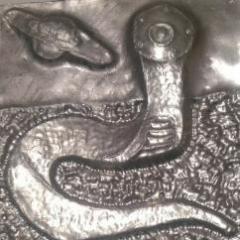
What did you do in the shop today?
Shabumi replied to Mark Ling's topic in Blacksmithing, General Discussion
I got the pitch mixed. It's still hot and gooey so I'll check how it turned out after it cools. The little test "coupon" made was sticky, but wiped off my hands with just a rag, so thats promising -
I got as far as the one where Robert Jordan died and Brandon Sanderson finished. I think there were a couple after that, but I didn't read them. I do enjoy Sandersons work though. His Mistborn series was a good one, with a magic system based on consuming metals and a magic system based on wearing metals, and the rare few who can do both. Though it does show the heroes drink vials of lead pellets to lend them strength, so its another one to suspend belief to read.
-
I have read them all too, and am in the same boat as you about him finishing, but I waited for the Wheel of Time series by Robert Jordan, so I won't lose sleep if he doesn't. I also watched the show. Its entertaining, just don't expect it to be the same as the books. The first season was word for word the first book, but after that they slowly took their own direction. By the end it's not even the same story. In the show they have one line, where a character was reading an old book and says something to the effect of "the ancients used to call dragonglass obsidian", though in the books there isn't that clarification. They were also casting dragonglass into short swords in the show. Maybe thats how they got the holes and the perfect channels for the steel bars. Pre cast blanks, just knap on an edge. If you screw up and break it, just melt it down and make another.
-
-
Looks similar to the egg pods made by preying mantis' (manti, mantes?) In this area.
-
Sure, if they fit in a single rate box from the post office. Otherwise I'll need to wait till I'm in your neck of the woods. I got the brick crushed and I managed to get the pine sap strained. It was harder than it sounds. I managed to ruin a sieve in doing so, luckily I bought one at a thrift store just for this purpose. I'll start a new thread for the mixing process.
-
This is all ponderosa pine sap, 3 trees worth. I can go and check if the sugar pines and bull pines on the property are weeping too. When I read the water part of the instructions my mind instantly went to seeing mozzarella being made. Though with mozzarella you don't want to overknead or you'll get a rubber ball, which is what I think im supposed to be aiming for here. I don't belive that pitch and wax are water soluble, and vitrified clay is alot less soluble than its base form, so maybe the kneading works the water solubles out like working slag out of wrought-iron when you fold it.
-
Saw some pitch dripping from one of the pines, so I started gathering for a batch of homemade repousse pitch. 20 minutes and I had a large salsa container full. I have an old brick I can crush and some beeswax. I think I'll try the recipe I copied from "on divers arts" Grind a piece of brick or tile very small and melt some pitch in an earthenware dish and add a little wax. When these are both melted, mix in the powdered tile and stir it vigorously and pour it out into water. When it begins to grow cold, dip both your hands into the water and knead it for a long time until you can stretch the composition and draw it out like a skin.
-
Thanks for the warning Glenn, we are very aware of brucellosis (ungulent fever). We have to vaccinate all our cows/heifers for it at 4 months old by law here in California. Its mostly passed through raw dairy products, though rarely can pass through the air from cells from an infected animal. We have to educate the natural foodies in the area who ask for raw milk from our cows about it. Most of the time they never heard that you could get sick from raw milk. We also educate people about trichinosis from undercooked pork, bear, horse and pinipeds. Your mostly safe from it from factory pork as they never touch actual dirt, so its tough for them pick it up, but if you raise it yourself or get it from the wild you MUST cook it till there is no pink in the middle
-
We've had help from an old timer like that, when it came time to preg check he would strip the top half of their cloths off because as he would say "Your hide cleans easier than your clothes". He knew what he was doing so I didn't argue, and I still haven't seen anyone who could preg check like him. Less than a minute and not only did you know if it was bred, you also knew how far along they were, down to the week. Ill be darned if he wasn't spot on every time too. That smell, and what the smell comes from, is a constant when working with large animals, you get so used to it you barely wipe your hands off before eating lunch, as long as your thumb, index and middle finger were visible it was time to eat, just hold your sandwich by the crust and toss the dirty part as an offering to the various fey for protection/fortune when your done (a tradition from the Cornish families in the area). Goats are great for poison oak too, cows are aweful. They rub up against it, then against each other, then when you work them someone ends up covered in it by the time we are done gathering, usually the person who never left the corral because they didn't want to chance getting it while gathering.
-
Your dad is a smart man. That reminds me of my dad teaching my sister to change a tire. He told her "I don't care if you ever use the skill, but its something you need to know how to do in an emergency" I do have to laugh though, The Glove is med-low on the ewww totem pole when it comes to ranch work. Everyones is different, but the top of my ewww totem pole would have to be dealing with cat manure *shudders*. Fly strike would be a close second.
-
Yeah, they swallow first and chew later. We dont have to worry about the steers or the sale calves, but we have to take precautions so our mother cows don't get hardware disease. They free range on forestry ground (legally) in the summer, and in their range is a ghost town and 2 other town sites that had burned or decayed away, so you never know what they will pick up.
-
You dont. I just sits there collecting. As the bits of metal rust, The rust passes without harm, but the bolus stays. You could gather it at harvest time, but it is generally considered a consumable. We would check to see if we had bolussed a cow by bringing a compass, if it pointed moo north, then the cow had been done. I've seen the scrap iron pile at our local mobile butchers home shop. You'd be surprised what a cow will swallow. Along with the expected bits of wire and nails I've seen fencing pliers, pocket knives and a couple horse (pony) shoes in that pile, all still stuck to the bolus'.
-
If you were in cattle country and they were magnetized I would guess magnetic bolus' for cows. They sit in the bottom of the first stomach and catch stray bits of metal that the cow eats and keeps it there instead of letting it pass through the rest of the intestinal tract. We've used them a couple times when we put our cows in a pasture that has alot of old fencing in it. Non-magnetized... perhaps a bolus to help keep an iron horse running strong
-
The standard sized ones should also have webbed front feet as a breed trait. They were water retrieval and flushing dogs. The goofy haircut had an important job too. The puffs kept the chest, head, tail tip, kidneys and pulse points warm while the dog was in the water for extended periods of time. I was always taught the difference between hair and fur was that fur shed yearly while hair needed to be cut or shorn. Our Dorper sheep are considered a "hair breed" yet they have fur that they shed each year, while the "wool breeds" have hair that need to be shorn. Just another way farmers make things more confusing.
-

What did you do in the shop today?
Shabumi replied to Mark Ling's topic in Blacksmithing, General Discussion
Made my first songcatcher this week. This was made from what I had on hand. Old fishing line that breaks under hand pressure. Extra wooden egg and paranoid from craft sets that the neices and nephews were finished with. 1/4 inch round stock for the 17inch rings. 1 inch tube stock for chimes, tuned to A, E, F and G. 5ft from top of ring to bottom of aluminum dancer. Already have commissions for 2 more, sans fishing line. Time to check ben Frank's for something more attractive and substantial. Any suggestions? 20200908_103728.mp4

